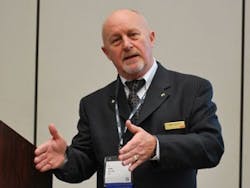Additive manufacturing is a relatively new way to make components lighter, stronger and sometimes less expensively. It also provides the capability to reduce component stock holdings and overheads, as well as the ability to produce unfinished components that are closer to their desired shape (near net shape), thus reducing subsequent machining using traditional methods. And with ABB’s simulation and off-line programming software, RobotStudio, the number of manufacturing sequence steps can be reduced, compressing manufacturing lead times.
The American Society for Testing and Materials (ASTM) F42 group formulated a set of standards (Standard Terminology for Additive Manufacturing Technologies, 2012) that classify the range of additive-manufacturing processes. 3D printing—a synonym for all additive manufacturing processes—can be broken down into seven categories, which include material extrusion, powder bed fusion, material jetting, binder jetting, vat photopolymerisation, sheet lamination and direct energy deposition. The processes vary in their methods of layer manufacturing, and individual processes differ depending on the material and machine technology used.
“With plasma, you can do 12 wires at the same time, which isn’t typical.” ABB’s Mark Oxlade on the advantages of additive manufacturing using direct energy deposition with arc plasma.
While similar in appearance to welding, one of the processes—direct energy deposition (DED)—is actually additive manufacturing. “The word ‘welding’ as defined by the American Welding Society conveys the joining of two or more pieces of metal,” explained Mark Oxlade, ABB’s market development manager—joining & cutting, who presented the latest information on DED and similar additive processes at ABB Customer World this week in Houston. “Welding is joining two parts together through fusion. DED is an additive-manufacturing process in which focused thermal energy is used to fuse materials by melting as they are being deposited.” Energy sources for DED machines include lasers, electron beams and arc plasma.
Direct energy deposition also differs from cladding, which is applying a uniform buildup of material on a surface. “Although DED systems can be used to apply a surface cladding, such use does not fit the current definition of additive manufacturing,” explained Oxlade. “Additive manufacturing is when a computer-aided design (CAD) file of the build features is converted into section cuts, representing each layer of material to be deposited. The DED machine then builds up material, layer by layer, so material is only applied where required to produce a part, add a feature or make a repair. Additive manufacturing is a new way of making things, so we have to design in a new way.”
It all adds up
The reasons for choosing an additive-manufacturing solution are many, but reducing the numbers of steps to near net shape is among the most important, Oxlade said. “If you can reduce the number of steps, then additive manufacturing is a good way to go.” said Oxlade, who shared some examples from maritime, airline, medical and automotive industries.
“Everyone has spare parts,” explained Oxlade. “They cost money. Every time an aircraft carrier goes to sea, it carries 7,000 tons of consumables and spares. But what if you can print your own replacement parts while at sea?” A 1% reduction in spares is the equivalent of two fully loaded planes. Meanwhile, the FDA has approved 3D printing of metal implants such as a custom chest plate for a cancer patient. And in automotive components, there’s 3D printing of metal car cylinder heads.
Project completion can be turbocharged with ABB’s RobotStudio, Oxlade continued. “Machining PowerPac is an add-on that makes it possible to create complex paths in just seconds. You start with a CAD file, then slice the 3D model and export G-code, which is imported into a CAM converter to create RAPID language. Then you can start printing with the robot. “RobotStudio is the real controller, not a simulation,” said Oxlade.
“For good CAD, we have path-following characteristics,” explained Oxlade. “It looks at things like friction and gravity. Our standard robots can be made 10 times more accurate by tuning. We know how to make a robot motion very accurate.”
Make mine plasma
Arc plasma is Oxlade’s preferred energy source for DED. “Plasma is a little more stable process,” said Oxlade, “which means higher quality assurance for additive manufacturing with robotic motion control.”
While ABB focuses on the software side, with RoboticStudio, its partners are making the welding heads. In a traditional electron-beam process, up to two wires can be in use simultaneously. “With plasma, you can do 12 wires at the same time, which isn’t typical,” explained Oxlade. “Plasma gives you a very clean weld. Spatter goes away. Also, most welding processes hate oil. With plasma, it burns off the oil before you get to it.”
Download the full report from ABB Customer World 2017
About the Author
Mike Bacidore
Mike Bacidore

Leaders relevant to this article:


